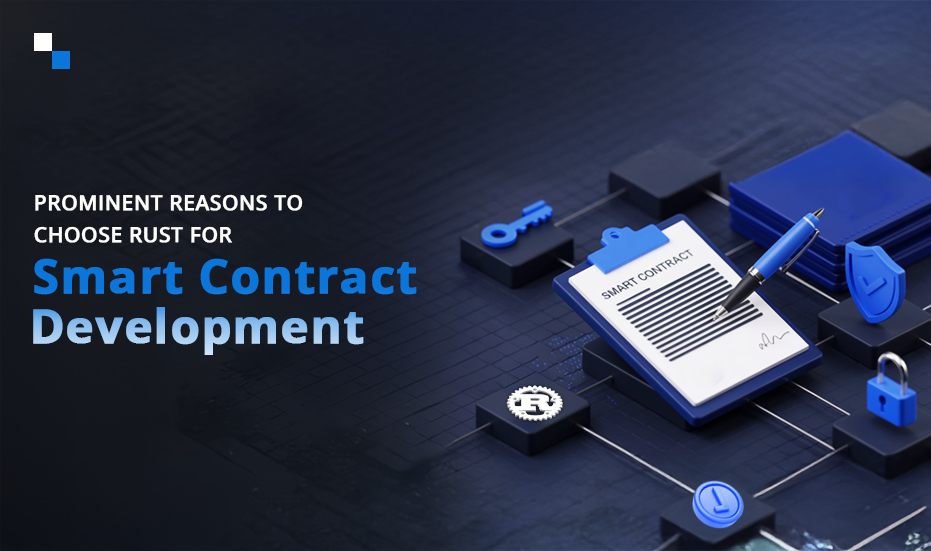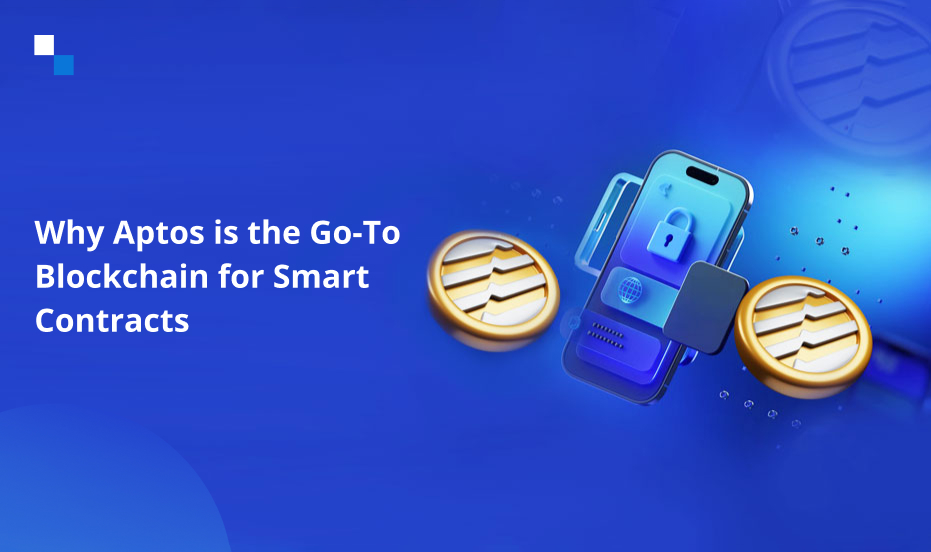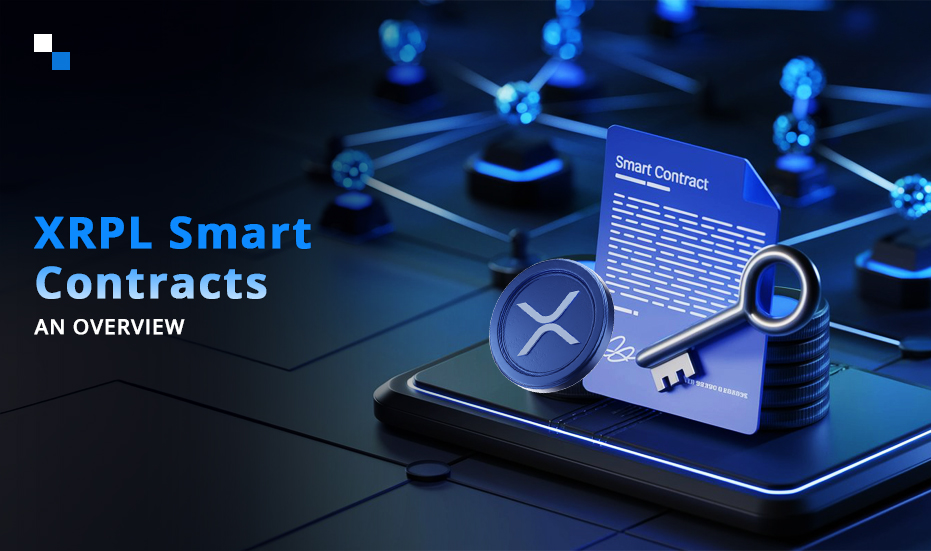
Real Estate Tokenization vs. Traditional REITs: Which Offers Better Returns?
January 22, 2025
Why the New & Emerging Exchanges Need a Market Making Bot in 2025?
January 23, 2025Many enterprises are increasingly adopting Rust for smart contract development due to its unmatched performance, memory safety, and concurrency capabilities. A real-life example of Rust’s growing popularity is Solana, one of the fastest and most scalable blockchain networks, which owes its high throughput and low latency to Rust. By leveraging Rust, Solana has successfully enabled enterprises like Serum and Mango Markets to build decentralized financial systems capable of handling thousands of transactions per second without compromising security. This demonstrates why Rust is not just a programming language but a strategic asset for enterprises aiming to develop high-performance and secure smart contracts in today’s competitive blockchain landscape. This blog covers the following pointers in detail:
- The Limitations of Traditional Smart Contract Languages
- Rust vs Solidity vs Move: Which Language is Better for Smart Contract Development?
- Prominent Reasons Why Enterprises Must Invest in Rust Smart Contract Development
- Best Practices for Rust Smart Contract Development
- Basic Steps to Rust Smart Contract Development
- Top Blockchain Platforms Supporting Rust-based Smart Contracts
- Conclusion
The Limitations of Traditional Smart Contract Languages
Traditional smart contract languages like Solidity present significant challenges for enterprise-grade deployments. These include:
-
Security Vulnerabilities: Historical exploits and ongoing security audits highlight inherent vulnerabilities in Solidity, posing substantial financial and reputational risks for businesses.
-
Performance Bottlenecks: Limited performance and high gas costs hinder scalability and restrict complex transactional logic, making them unsuitable for high-throughput enterprise applications.
-
Maintenance and Auditing Complexity: Debugging and auditing complex Solidity code can be challenging, increasing development time and costs.
Rust vs Solidity vs Move: Which Language is Better for Smart Contract Development?

Prominent Reasons Why Enterprises Must Invest in Rust Smart Contract Development
-
Memory Safety Without Garbage Collection
Rust eliminates common programming errors, such as null pointer dereferencing and buffer overflows, through its powerful ownership model. This ensures memory safety at compile time without the need for garbage collection, making Rust smart contract development more efficient and less prone to vulnerabilities.
-
High Performance and Scalability
Smart contracts often require high computational efficiency, especially when deployed on blockchain platforms with resource constraints. Rust’s performance is on par with C and C++, offering low-level control while enabling the development of high-performance smart contracts. Enterprises can leverage Rust to build scalable solutions that handle increasing transaction volumes seamlessly.
-
Strong Developer Ecosystem
Rust has a rapidly growing developer community, with extensive libraries and frameworks designed to simplify blockchain and smart contract development. Tools like Ink! for Polkadot and Anchor for Solana enable developers to streamline their workflows and build robust smart contracts more effectively.
-
Multi-Blockchain Compatibility
One of Rust’s standout features is its compatibility with multiple blockchain platforms. Enterprises exploring diverse ecosystems can rely on Rust for smart contracts to build solutions on Polkadot, Solana, Near Protocol, and more. This flexibility makes it a versatile choice for organizations aiming to diversify their blockchain initiatives.
-
Enhanced Security for Mission-Critical Applications
Security is paramount in blockchain applications, and Rust excels in this area. Its robust type system, coupled with strict compile-time checks, minimizes the likelihood of runtime errors. Enterprises can build secure smart contracts with Rust, reducing the risk of exploits and vulnerabilities that could jeopardize their operations.
-
Future-Ready for Web3 Innovations
Rust’s alignment with cutting-edge technologies like WebAssembly (Wasm) positions it as a future-ready choice for smart contract development. WebAssembly enhances the execution of Rust smart contracts, ensuring faster and more reliable performance across blockchain networks.
Best Practices for Rust Smart Contract Development
The following best practices are crucial for achieving optimal performance in Rust blockchain development:
Data Structures and Algorithms
- Choose Efficient Data Structures: Select data structures appropriate for the specific use case. For example, using HashMap for lookups provides O(1) average time complexity, while using Vec for sequential access is more efficient. Avoid unnecessary cloning or copying of data, as this can be computationally expensive.
- Optimize Algorithms: Implement algorithms with optimal time and space complexity. Analyze the performance characteristics of different algorithms and choose the most efficient one for the task at hand. Consider using specialized crates for specific tasks, such as cryptographic operations or data serialization.
Storage Management
- Minimize Storage Reads and Writes: Storage operations are among the most expensive operations in smart contracts. Minimize the number of reads and writes to storage by caching frequently accessed data in memory or using appropriate storage patterns.
- Use Efficient Storage Patterns: Utilize storage patterns like mapping and enumeration effectively. Understand the gas costs associated with different storage operations and design your contract’s storage layout accordingly. Avoid storing large amounts of data directly in contract storage; consider using off-chain storage solutions for large datasets.
Gas Optimization
- Understand Gas Costs: Familiarize yourself with the gas costs associated with different operations in the target blockchain environment. This knowledge is crucial for writing gas-efficient code.
- Minimize Loop Iterations: Loops can be computationally expensive. Minimize the number of iterations and avoid nested loops whenever possible. Consider using iterators and functional programming techniques for more efficient data processing.
- Avoid Unnecessary Computations: Avoid performing unnecessary computations or redundant operations. Analyze your code for potential optimizations and remove any unnecessary logic.
- Use #[inline] Attribute: Use the #[inline] attribute judiciously to encourage the compiler to inline small functions, potentially reducing function call overhead.
Code Optimization
- Use #[no_std] When Possible: Using #[no_std] allows you to compile your contract without the standard library, reducing the contract’s size and potentially improving performance. This is especially relevant for resource-constrained environments.
- Profile Your Code: Use profiling tools to identify performance bottlenecks in your code. This allows you to focus your optimization efforts on the most critical areas.
- Minimize External Calls: External calls to other contracts can be expensive. Minimize the number of external calls and consider consolidating functionality within a single contract if possible.
Smart Contract Design Principles
- Favor Immutability: Immutability can simplify reasoning about code and improve performance by reducing the need for synchronization and locking.
- Use Libraries and Crates: Leverage existing libraries and crates for common tasks. This can save development time and improve performance by utilizing optimized code.
- Thorough Testing and Auditing: Thoroughly test and audit your smart contracts to identify and fix performance issues and security vulnerabilities.

Basic Steps to Rust Smart Contract Development
Step 1: Set up the Development Environment
- Install Rust: If you don’t have it already, install Rust using rustup:
Bash
curl –proto ‘=https’ –tlsv1.2 -sSf https://sh.rustup.rs | sh - Install Necessary Tools: Each platform has its own set of tools. You’ll generally need:
- A build tool (like Cargo for Rust).
- A command-line interface (CLI) for interacting with the blockchain.
- SDKs or libraries for smart contract development.
- Choose an IDE (Optional): While not strictly required, an IDE like Visual Studio Code with the Rust Analyzer extension can greatly improve your development experience.
Step 2: Write the Smart Contract
- Define the Contract’s Logic: Use Rust to implement the contract’s functions, data structures, and state transitions.
- Use Platform-Specific Libraries: Utilize the platform’s SDK or libraries to interact with the blockchain’s features (e.g., storage, accounts, transactions).
- Handle Errors and Edge Cases: Implement robust error handling to prevent unexpected behavior.
Step 3: Build the Smart Contract
- Compile to WebAssembly (Wasm): Most blockchain platforms execute smart contracts in a Wasm environment. You’ll need to compile your Rust code to a Wasm binary.
- Optimize for Gas (if applicable): Some platforms (like Ethereum and those inspired by it) use a gas mechanism to measure computational cost. Optimize your code to minimize gas consumption.
Step 4: Test the Smart Contract
- Write Unit Tests: Test individual functions and components of your contract.
- Write Integration Tests: Test the interaction between different parts of your contract and with the blockchain environment.
- Use Testing Frameworks: Utilize platform-specific testing frameworks or tools.
Step 5: Deploy the Smart Contract
- Connect to a Blockchain Network: Connect to a local development network, a test network, or the main network.
- Use the Platform’s CLI or SDK: Use the platform’s tools to deploy your compiled Wasm binary to the blockchain.
- Pay Deployment Fees: Some platforms require you to pay a fee to deploy your contract.
Top Blockchain Platforms Supporting Rust-based Smart Contracts
Several prominent blockchain platforms are leading the charge in supporting Rust for smart contracts:
1. Solana
- Focus: High-performance, high-throughput blockchain optimized for decentralized finance and other demanding applications.
- Rust Integration: Solana’s core client and smart contract development environment are built using Rust. Developers use Rust to write programs that interact with the Solana runtime.
- Key Advantages: Extremely fast transaction speeds, low transaction costs, and a thriving ecosystem. This makes Solana an excellent choice for applications requiring high performance, such as decentralized exchanges and high-frequency trading platforms.
- Relevance to Enterprises: Solana is suitable for enterprises requiring high throughput and low latency, such as financial institutions and gaming companies. Its focus on performance makes Rust blockchain development on Solana ideal for complex financial instruments and high-volume transactions.
2. Polkadot/Substrate
- Focus: Interoperability and scalability through its unique parachain architecture. Substrate is the framework used to build parachains and is heavily reliant on Rust.
- Rust Integration: Substrate, the framework for building parachains on Polkadot, is written in Rust. ink!, a Rust-based embedded domain-specific language, is used for writing smart contracts that can be deployed on Substrate-based blockchains.
- Key Advantages: Highly modular and customizable, allowing developers to build purpose-built blockchains. Polkadot’s interoperability allows different blockchains to communicate with each other.
- Relevance to Enterprises: Polkadot’s interoperability and customizability make it attractive for enterprises needing to connect with existing systems or build specialized blockchain solutions. Rust smart contract development with ink! allows for secure and efficient execution within the Polkadot ecosystem.
3. Near Protocol
- Focus: Developer-friendly platform with a focus on usability and scalability.
- Rust Integration: Near supports smart contract development using Rust, allowing developers to leverage Rust’s performance and security benefits.
- Key Advantages: User-friendly development tools, sharding for scalability, and a focus on usability.
- Relevance to Enterprises: Near’s focus on usability and scalability makes it suitable for enterprises looking to build user-friendly decentralized applications. Smart Contract Development with Rust on Near benefits from the platform’s focus on developer experience.
4. Cosmos SDK
- Focus: Building interoperable and application-specific blockchains.
- Rust Integration: CosmWasm allows developers to write smart contracts in Rust that can be deployed on Cosmos-based blockchains.
- Key Advantages: Modularity, interoperability, and sovereignty. Cosmos allows developers to create their own sovereign blockchains tailored to specific needs.
- Relevance to Enterprises: Cosmos provides the flexibility to build custom blockchain solutions, making it ideal for enterprises with specific requirements. Using Rust for smart contracts with CosmWasm provides security and performance within the Cosmos ecosystem.
5. Stellar
- Focus: Facilitating cross-border payments and tokenization of assets.
- Rust Integration: Stellar has introduced Soroban, a smart contract platform that uses Rust.
- Key Advantages: Focus on real-world financial applications, fast and low-cost transactions, and strong regulatory compliance.
- Relevance to Enterprises: Stellar with Soroban is highly relevant for financial institutions and businesses involved in cross-border payments, asset tokenization, and other financial services. Rust smart contract development on Soroban enhances the security and performance of these applications.

Conclusion
Writing high-performance smart contracts in Rust requires a combination of technical expertise and adherence to best practices. By following these best practices and leveraging Rust’s strengths, enterprises can build scalable, secure, and efficient smart contracts to stay ahead in 2025 and beyond. However, beginners may find it difficult to understand the whole development and deployment process. In such a case, partnering with a renowned smart contract development company like Antier would be a wise decision.



